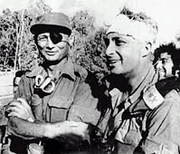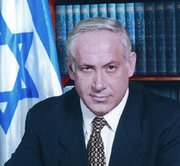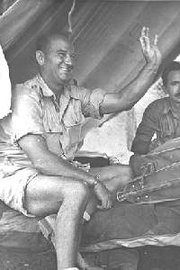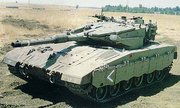History of the Israel Defense Forces
|
|
- Main article: Israel Defense Forces.
The history of the Israel Defense Forces is intertwined with history of the establishment of the State of Israel in 1948. The Israel Defense Forces (IDF) were formed following the Declaration of the Establishment of the State of Israel, May 14, 1948 to "defend the existence, territorial integrity and sovereignty of the state of Israel" and "to protect the inhabitants of Israel and to combat all forms of terrorism which threaten daily life". The predecessors to the IDF were the Haganah (in particular, its operative detachment, the Palmach) and the British armed forces, in particular the Jewish Brigade that fought as part of the British army during World War II.
After the establishment of the IDF, the two Jewish guerilla armies, the Irgun and Stern gang came under control of the IDF. But they were allowed to operate independently in Jerusalem until the end of the 1948 Arab-Israeli war after which they eventually disbanded.
| Contents |
Timeline and major events
Before 1948
Following the 1947 UN Partition Plan which divided the British Mandate of Palestine, the country became increasingly volatile and fell into a state of civil war between the Jews and Arabs. In accordance with Plan Dalet the Haganah tried to secure the areas alloted to the Jewish state in the partition plan and the blocks of settlements that were in the area alloted to the Arab state.
The first Arab-Israeli war
- See the main article: 1948 Arab-Israeli War.
David Ben-Gurion proclaimed the Declaration of the Establishment of the State of Israel, May 14, 1948. His first order was the formation of the IDF - The Israeli Defence Forces.
The IDF was based on the personnel who had served in the Haganah and the Palmach and was declared as the only legal armed force in Israel. Another main source of manpower was the immigrants from Europe. Some of them Holocaust survivors and others veterans from World War II.
Following the declaration of independence in 1948, Arab armies invaded Israel. Egypt came from the south, Lebanon and Syria from the north, and Jordan from the east backed by Iraqi and Saudi troops.
In the initial phase of the war, the IDF was inferior in both numbers and armament. Due to a number of reasons, the Arabs never managed to exploit their superiority in numbers. The Israelis managed to successfully defend themselves in virtually all battlefields with the notable exception of East Jerusalem. After the first truce June 11 to July 8, the Israelis managed to seize the initiative due to new troop enrollments and supplies of arms. Notable achievements of the IDF incclude the conquest of Eilat (Um Rashrash), Zefat, Nazareth, Haifa and the liberation of the Galilee and the Negev. The war continued until July 20, 1949, when the cease-fire with Syria was signed. By then the IDF had managed to repel the Egyptians to the Gaza Strip while the Kingdom of Jordan took over the West Bank and east Jerusalem.
See 1949 Armistice Agreements.
1949-1956
In those years the IDF started to rebuild itself as a modern army. It acquired heavier weapons and established an armored corps and the Israeli Air Force.
In order to enhance the morale and organization of the army and to combat the resurgent problem with Palestinian infiltration, Unit 101 was formed. It was led by Ariel Sharon (who later became Prime Minister in Israel), and carried out a number of retaliatory strikes on Jordanian territory to deter the infiltrators. After the notorious Qibya Massacre in 1953 it was merged with the Paratroopers Battalions and Sharon became its commander. Unit 101 is regarded as the mother of the IDF's strike force units.
In those years the IMI Uzi SMG and the FN FAL rifle were issued as standard infantry weapons.
The 1956 Sinai campaign
- See the main article: Suez Crisis.
From 1954 and 1955 Egypt established a special force unit known as the Fedayeen to terrorize Israel's civilians, such as ambushing civilan buses. It led to the escalation of hostilities over the Israeli-Egyptian border and eventually contributed to the 1956 Suez War.
When President Gamal Abdul Nasser, encouraged by support from the Soviet Union, nationalized the Suez Canal, United Kingdom and France sent in their paratroopers, and recaptured the canal. Simultaneously, the IDF launched a full scale attack into Sinai. Israeli armour, equipped with tanks, such as M4 Sherman and AMX-13 quickly defeated the Egyptian forces and took control over the canal. Israel withdrew from Sinai under international pressure, particularly by the USA and its Secretary of State, John Foster Dulles. But the IDF had achieved numerous goals; the borders dramatically tranquilized, Nasser promised to disband the Fedayeen, the Suez Canal was once again open to shipping and maybe most important of all, Israel had illustrated its military strength. The successful war elevated the reputation of the IDF and contributed a lot to the morale of the soldiers.
1956-1966
Following the successful campaign in Sinai, the IDF used this relative quiet decade to arm on a great scale and increase military professionalism. The main suppliers of weapons were France and USA which sold rifles, tanks and even jet fighters - the renowned Dassault Mirage III to Israel.
The peak of France's assistance was the construction of the nuclear reactor in Dimona in 1960.
The 1967 Six-Day War
- See the main article: Six-Day War.
The reasons for the war were the concentration of 100,000 Egyptian troops in the Sinai Peninsula and the closure of the Straits of Tiran to Israeli ships. Those two steps of Gamal Abdul Nasser were interperated by the Israeli government as Egyptian preparation for war, and after forming a unity government, despite international pressure, the Israelis decided on a massive preemptive strike.
On the morning of June 5, 1967, the Israeli Air Force (IAF) launched a massive airstrike that destroyed the majority of the Egyptian air force on the ground. By noon, the Egyptian, Jordanian and Syrian air forces, with about 450 aircraft, were annihilated. This pre-emptive strike was code-named Operation Red Sheet, Mivtza Sadin Adom.
The Egyptians presuaded Syria and Jordan to join the war by lying to them and reporting on "amazing victories" at Sinai. The two Arab countries reluctantly joined the war. Jordan by shelling West Jerusalem and Syria by entering Israel from the Golan Heights.
Meanwhile, the IDF ground forces quickly overran the Egyptian army in Sinai and were about to reach Alexandria. About 15,000 Egyptian soldiers were killed, 4482 fell into captivity and 80% of the Egyptian tanks were destroyed. 338 Israeli were killed in Sinai and the Israel losses there were about 63 tanks.
All of the Sinai peninsula was captured. The IDF later captured the Golan Heights from the Syrians and the West Bank from Jordan.
Generals_Rabin_Dayan_Narkis_Jerusalem_1967.jpg
On June 7 Israeli troops (the Harel unit; Yerushalmi unit; and elite paratroopers accompanied by tanks) captured the Old City of Jerusalem The conquest of the Western Wall and Temple Mount was considered as the highlights of the war and a dramatical and emotional peak by the Israeli people. The reunifaction of east and west Jerusalem as one city under Jewish control were celebrated widely in Israel.
The Six-Day War had great consequences for the state of Israel and the IDF. In six days Israel had tripled its territory and defeated three Arab armies - Egypt, Jordan and Syria. Yitzhak Rabin, Moshe Dayan, Israel Tal, Moshe Peled and Mordechai Gur were admired by the public as "war heroes" while the IAF pilots won unprecedented prestige and were considered to be "the best pilots in the world" (even today, the IAF is considered to be one of the most competent air forces in the world).
The 1968-1970 War of Attrition
- See the main article: War of Attrition.
Israel's pre-emptive strike in the Six Day Wars resulted in a French embargo banning all weapon sales to Israel. Israel overcame the embargo by finding other suppliers (such as the USA) and developing its own weapons - for example: The Kfir fighter jet.
After the Six-Day War was over, IDF outposts on the Suez Canal were shelled by the Egyptian army. It was a long and bitter war that ended after three years due to Israeli air superiority.
There were also frictions and battles with Syrian forces on the northern border. In the Israeli reprisal operation ("Three Day Battles" June 24 - June 27, 1970) about 350 Syrian soldiers were killed.
The 1973 Yom Kippur War (1973)
- See the main article: Yom Kippur War.
The Yom Kippur War, also known as the "October War" in Arab countries broke Israeli over-confidence created after the glorious victory of the Six-Day War. This time, Jordan stayed out and wasn't involved in the war. The war opened on October 6 1973, the holiest Jewish holiday of Yom Kippur.
Egypt and Syria attempted to regain the territory under Israeli occupation by force. Their armies launched a joint surprise attack on the Jewish Yom Kippur holiday (the most sacred day of all in which each Jew must atone for his sins, pray and avoid eating and drinking) -- the Syrian forces attacking fortifications in the Golan Heights and the Egyptian forces attacking fortifications around the Suez Canal and on the Sinai Peninsula. The troops inflicted heavy casualties on the Israeli army. After three weeks of fighting, though, and with U.S. air-lifted reinforcements of weapons and equipments (first shipment arrived on October 14 1973), the IDF pushed the attacking forces back beyond the original lines.
In the Golan Heights, small groups of brave tank commanders such as Avigdor Kahalani managed to hold back dozens of Syrian tank. By October 10, the IDF recaptured the entire Golan Heights and on October 11 Israeli armored forces invaded Syria and destroyed the Iraqi reinforcements. On October 22, the Golani infantry brigade captured mount Hermon (an important strategic outpost).
In the Sinai Peninsula, Israeli armour barely managed to stop the overwhelming Egyptian attack. The Egyptians attacked with 2,000 tanks while there were only 300 Israeli tanks to defend the area. Israeli armored forces suffered heavy casualties on the first three days and were forced to withdraw from the Suez Canal outposts.

After being reinforced by reserve forces, the IDF launched a counter-attack. On October 14, General Ariel Sharon managed to cross over the Suez Canal and cause havoc in the logistic back areas of the Egyptian army. On October 24, after Israeli troops were 101 km away from Cairo, and under heavy international pressure, a cease-fire treaty was signed and the war was over.
The price of the war was heavy. 2,700 Israelis were killed and 5,600 were wounded. About 300 Israeli soldiers were taken captive. The Egyptians paid a higher price, with 12,000 dead, 35,000 wounded and 8,400 taken captive. 3,000 Syrian soldiers were killed, 5,600 were wounded and 411 taken captive.
In Israel, the war caused a public outrage, forcing the government to appoint an investigation commission. The Agranat Commission found serious flaws in the functioning of the intelligence forecasting branch, which failed to foresee the war and ignored various warnings. The Chief of Staff, David Elazar ("Dado") resigned after harsh criticism by the commission. Although the commission praised Israeli Prime Minister Golda Meir on her leadership during the war, she resigned following the war and was replaced by Yitzhak Rabin.
1974-1978
Until 1974, the IDF was countering Syrian and Egyptian attacks meant to weaken IDF posts on the border and force the Israeli government to withdraw. However, the IDF managed to sustain low casualties. The IDF reprisal strikes on the Egyptians and Syrians inflicted heavy casualties. After international negotiations in 1974, the attacks stopped.
Following the French embargo and the US air-lift of supplies, weapons and ammunition, the IDF started to base itself upon American and Israeli made weapons and technologies. The American M16 assault rifle entered service along with the Galil assult rifle - an Israeli variant of the Soviet AK-47. M14 were issued as sniper rifles along with surplus of M1 Carbines given to the Police.
In those years the IDF invested most of its efforts in countering international terror, such as the Munich Massacre, committed by the PLO following its deportion from Jordan to Lebanon in the "Black September" of 1970. The PLO focused mainly on hijacking airlines and kidnapping and its terrorists hijacked several commercial airline flights.
In 1976, a group of PLO terrorist hijacked an airliner with 83 Israeli passengers and held them hostages in the Entebbe airport in Uganda. Israeli elite SF unit - Sayeret Matkal - went on a complex hostages-rescue operation and managed to save 80 of the passengers, with only one soldier lost the commander, colonel Jonathan Netanyahu, brother of Benjamin Netanyahu. The operation, officially called Operation Johnathan but widely referred as Operation Entebbe, is regard by many military experts as one of the brightest and successful covert operation ever conducted.
In those years the IAF received a new generation of warplanes. In 1977 the first F-15 Eagle American warplanes arrived in Israel and only a year later, they logged their first kill in the world when IAF F-15s shot down Syrian MiG (Mikoyan-Gurevich) fighters. In 1980 the F-16 Fighting Falcon arrived and the model's first ariel kill was also credited to the Israeli Air Force.
1978 Operation Litani
- See the main article: Operation Litani
Because of waves of terrorist attacks (most notable is the road massacre of 37 civilians) coming from the PLO in Lebanon, the IDF undertook Operation Litani, a wide-ranging and thorough anti-terrorist operation which included occupying part of Southern Lebanon in 1978.
1979-1981
In 1979 the first Israeli-made Merkava Mk1 main battle tank entered into service. The tank was fully developed and manufactured by Israel and exceeded the enemies' tanks in every parameter. It first saw active service in Lebanon and proved to be great success.
In 1979 the Israel-Egypt Peace Treaty was signed, when Menachem Begin and Anwar Sadat agreed on peace in return for Israel giving the entire Sinai Peninsula to Egypt. The peace agreement, still valid today, closed the bitter southern front and let the IDF focus on the raging northern border.
In 1981 the Israeli Air Force destroyed Iraq's Osiraq nuclear reactor. The Israeli government suspected that the Iraqis would use the nuclear reactor to build atomic weapons (WMD). On June 7, four F-16 fighters, covered by F-15 jets, flew 1,100 km to Iraq from Israel, and bombed the nuclear reactor, thus, thwarting the Iraqi nuclear program and serverely holding back the Iraqi plans for getting a nuclear bomb.
1982 Operation Peace for Galilee
- See the main article: 1982 Invasion of Lebanon.
On 6 June 1982, following an assassination attempt against its ambassador in London by the Abu Nidal Organization, Israeli forces under direction of Defense Minister Ariel Sharon invaded southern Lebanon in their "Operation Peace for the Galilee." They eventually reached as far north as the capital Beirut in an attempt to drive the PLO forces out of the country.
Appendices
List of Chiefs of the General Staff
The Chief of the General Staff (in Hebrew: רמטכ"ל, pronounced: Ramatkal) is the highest commander of the IDF and answers to the Defense minister and the Prime minister. All Ramatkals have the rank of Lieutenant General or General (in Hebrew: רב אלוף, pronounced: Rav Aluf).
M_Yaalon_larger.jpg
- Yaakov Dori (1948-1949)
- Yigael Yadin (1949-1952)
- Mordechai Maklef (1952-1953)
- Moshe Dayan (1953-1958) "Musa"
- Chaim Laskov (1958-1961)
- Tzvi Tzur (1961-1964)
- Yitzhak Rabin (1964-1968)
- Chaim Bar-Lev (1968-1972)
- David Elazar "Dado" (1972-1974)
- Mordechai Gur "Mota" (1974-1978)
- Rafael Eitan "Raful" (1978-1983)
- Moshe Levi (1983-1987) "Moshe Vachetsi"
- Dan Shomron (1987-1991)
- Ehud Barak (1991-1995) "Udi"
- Amnon Lipkin-Shahak (1995-1998)
- Shaul Mofaz (1998-2002)
- Moshe Ya'alon "Bugi" (2002-2005)
- Dan Halutz (assumed command June 1, 2005)
Other famous generals and soldiers

- Yanush Ben Gal, 1973 Yom Kippur War hero, held back Syrian forces
- Tat-Aluf (Brigadier General) Efi Eitam, highest ranking religious combat general, head of Mafdal party
- Tat-Aluf Arie Eldad, chief military physician, professor of medicine
- Aluf-Mishne (Colonel) Imad Fares, highest Druze officer, commander of Givati Brigade (2001-2003)
- Meir Har-Zion, Unit 101 commando raider
- Avigdor Kahalani, 1973 Yom Kippur War general, held back Syrian forces
- Zvika Greenberg, 1973
- Colonel Yonatan Netanyahu, a war hero of Sayeret Matkal, killed in Operation Entebbe
- Meir Pail, historion
- Aluf (Major General) "Musa" Moshe Peled, armor general
- Aluf Mishne Ilan Ramon, senior F-16 pilot, bombed Iraqi reactor in 1981, first Israeli astronaut, died in the Columbia Space Shuttle disaster
- Aluf Ariel Sharon, commander of Unit 101, general of armored brigade during 1973 Yom Kippur War, prime minister
- Tat-Aluf Yiftah Spektor, senior F-16 pilot, bombed Iraqi reactor
- Aluf "Talik" Israel Tal, the "Father" of the Merkava main battle tank project
- Aluf Matan Vilnai, general and Israeli Labor party member
- Aluf Amram Mitzna, general, former Labor party leader
- Aluf Itzhak Mordechai, senior paratroop commander, former defense minister
- Benjamin (Bibi) Netanyahu, (Sayeret Matkal) commando officer, former prime minister.
- Admiral Amy Ayalon, commander of the Israeli Navy and later head of the Shin Bet internal security service.
- Aluf Meir Zorea, Major-General and Commander of Tank Corps during 1967 War.







